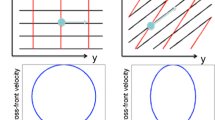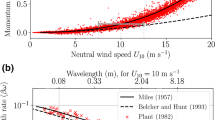Abstract
We present research on the excitation of ocean surface wind waves in non-homogeneous situations, for the case of a deep water strait in the presence of a constant wind, blowing perpendicular to the coast line. The statistical wave model used is based on the Hasselmann equation with high-wavenumbers wave-breaking dissipation, exact non-linear four-wave interaction, and ZRP (Zakharov-Resio-Pushkarev (Zakharov et al. Nonlin Process Geophys 24:581–597 2017) wind input term. At the first stage, the waves propagate in the wind direction in a step-like moving front manner, which is the combination of self-similar fetch-limited and duration-limited solutions of the Hasselmann equation. The second stage begins after intermediate self-similar linear asymptotics for wave energy is built along the fetch. Beginning with that time, the wave groups, propagating across and against the wind due to nonlinear interaction, are observed. Despite the absence of long-wave dissipation, the system asymptotically evolves into a complex quasi-stationary state, comprised of the self-similar “wind sea” in the wind direction, and quasi-monochromatic waves, radiating close to orthogonally with respect to the wind, while slightly tilting from perfectly orthogonal to the wind direction, with the angle slant increasing toward the wave turbulence origination shore line, and reaching 15∘ close to it. The total wave energy in the asymptotic state exceeds the wave sea energy propagating along the wind by a factor of two due to the presence of quasi-orthogonal and counter the wind wave fields. Very similar turbulence structure was previously observed experimentally; this paper presents a theoretical explanation of these results.


























Similar content being viewed by others
References
Ardag D, Resio D (2019) Inconsistent spectral evolution in operational wave models due to inaccurate specification of nonlinear interactions. J Phys Oceanogr 49(3):705–722. https://doi.org/10.1175/JPO-D-17-0162.1
Badulin SI, Babanin AV, Resio DT, Zakharov VE (2007) Weakly turbulent laws of wind-wave growth. J Fluid Mech 591:339–378
Badulin SI, Zakharov VE (2012) The generalized Phillips’ spectra and new dissipation function for wind-driven seas. arXiv:1212.0963 [physics.ao-ph], pp 1–16
Cavaleri L, Abdalla S, Benetazzo A, Bertottia L, Bidlot JR, Breivik O, Carniela S, Jensen RE, Portilla-Yandune J, Rogers WE, Roland A, Sanchez-Arcilla A, Smith JM, Staneva J, Toledo Y, van Vledder GP, van der Westhuysen AJ (2018) Wave modelling in coastal and inner seas. Prog Oceanogr 167:164–233. https://doi.org/10.1016/j.pocean.2018.03.010
Chalikov D (1995) The parameterization of the wave boundary layer. JPO 25:1333–1349
Dommermuth DG, Yue KP (1987) A high-order spectral method for the study of nonlinear gravity waves. J Fluid Mech 184:267–288. https://doi.org/10.1017/S002211208700288X
Donelan MA, Curcic M, Chen SS, Magnusson AK (2012) Modeling waves and wind stress. J Geophys Res 117:C00J23. https://doi.org/10.1029/2011JC007787
Ardhuin F, Herbers T, Watts K, Vledder GV, Jensen R, Graber H (2007) Swell and slanting-fetch effects on wind wave growth. J Phys Oceanogr 37(4):908–931. https://doi.org/10.1175/JPO3039.1
Fedorenko RP (1994) Introduction into computational physics. Nauka, Moscow. in Russian
Hasselmann K (1962) On the non-linear energy transfer in a gravity-wave spectrum. Part 1. General theory. J Fluid Mech 12:481–500
Hasselmann K (1963) On the non-linear energy transfer in a gravity wave spectrum. Part 2. Conservation theorems; wave-particle analogy; irreversibility. J Fluid Mech 15:273–281
Hsiao SV, Shemdin OH (1983) Measurements of wind velocity and pressure with a wave follower during MARSEN. JGR 88:9841–9849
Hwang PA, Wang DW, Rogers WE, Kaihatu JM (2000) A discussion on the directional distribution of wind-generated ocean waves. In: Resio D T (ed) 6th International workshop on wave hindcasting and forecasting, Monterey. Meteorological Service of Canada Environment Canada, Enviroment Canada, 4905 Dufferin Street M3H 5T4. http://resolver.tudelft.nl/uuid:ed727b97-db13-432c-854d-09a547c3654e, pp 273–279
Hwang PA, Wang DW, Rogers WE, Swift RN, Yungel J, Krabill WB (2001a) Bimodal directional propagation of wind-generated ocean surface waves. https://doi.org/10.13140/RG.2.1.4591.5689
Hwang PW, Wang WD, Rogers WE, Kaihatu J, Yungel J, Swift R, Krabill W (2001b) Bimodal directional distribution of the second kind: resonant propagation of wind-generated ocean waves. NRL Review, pp 160–162. https://www7320.nrlssc.navy.mil/pubs/2001/rogers-2001.pdf
Hwang P (2002) Retondo080102bimodal. https://doi.org/10.13140/RG.2.1.2101.2001
Hwang PA, Wang DW, Yungel J, Swift RN, Krabill WB (2019) Do wind-generated waves under steady forcing propagate primarily in the downwind direction? arXiv:1907.01532v1
Kalitkin NN (1978) Chislennye metody. Nauka, Moscow. in Russian
Komen GJ, Hasselmann S, Hasselmann K (1984) On the existence of a fully developed wind-sea spectrum. J Phys Oceanogr 14:1271–1285
Korotkevich AO, Pushkarev AN, Resio D, Zakharov VE (2008) Numerical verification of the weak turbulent model for swell evolution. Eur J Mech B - Fluids 27:361–387
Long C, Resio D (2007) Wind wave spectral observations in Currituck Sound, North Carolina. JGR 112:C05001
Perrie W, Zakharov VE (1999) The equilibrium range cascades of wind-generated waves. Eur J Mech B/Fluids 18:365–371
Pushkarev AN, Zakharov VE (1996) Turbulence of capillary waves. Phys Rev Lett 76:3320
Pushkarev AN, Zakharov VE (2013) Nonlinear generation of surface waves against the wind in a limited fetch growth model. In: 20th meeting WISE. ECMWF, ECMWF, College Park
Pushkarev A (2014) Nonlinear generation of surface waves against the wind in limited fetch growth model. J Phys Conf Ser 510:012048
Pushkarev A (2018) Comparison of different models for wave generation of the Hasselmann equation. Procedia IUTAM 26:132–144. https://doi.org/10.1029/2011JC007787
Pushkarev A, Resio D, Zakharov V (2003) Weak turbulent approach to the wind-generated gravity sea waves. Physica D 184:29–63
Pushkarev A, Zakharov V (2016) Limited fetch revisited: comparison of wind input terms, in surface wave modeling. Ocean Model 103:18–37. https://doi.org/10.1016/j.ocemod.2016.03.005
Pushkarev A, Zakharov V (2020) Nonlinear amplification of ocean waves in straits. Theor Math Phys 203:534–546. https://doi.org/10.1134/S0040577920040091
Resio D, Perrie W (1989) Implications of an f− 4 equilibrium range for wind-generated waves. JPO 19:193–204
Resio DT, Long CE, Vincent CL (2004) Equilibrium-range constant in wind-generated wave spectra. J Geophys Res 109:CO1018
Resio DT, Long CE (2007) Wind wave spectral observations in Currituck Sound, North Carolina. J Geophys Res 112:C05001
Rogers W, Vledder GPV (2013) Frequency width in predictions of windsea spectra and the role of the nonlinear solver. Ocean Model 70:52–61. https://doi.org/10.1016/j.ocemod.2012.11.010
Simanesew AW, Krogstad HE, Trulsen K, Nieto Borge JC (2018) Bimodality of directional distributions in ocean wave spectra: a comparison of data-adaptive estimation techniques. J Atmos Ocean Technol 35(2):365–384. https://doi.org/10.1175/JTECH-D-17-0007.1
Snyder RL, Dobson FW, Elliott JA, Long RB (1981) Array measurements of atmospheric pressure fluctuations above surface gravity waves. J Fluid Mech 102:1–59
Tracy B, Resio D (1982) Theory and calculation of the nonlinear energy transfer between sea waves in deep water. WES report 11. U.S. Army Engineer Waterways Experiment Station, Vicksburg
Tsagareli KN, Babanin AV, Walker DJ, Young RI (2010) Numerical investigation of spectral evolution of wind waves. part i: Wind-input source function. J Phys Oceanogr 40(4):656–666. https://doi.org/10.1175/2009JPO4345.1
Webb DJ (1978) Non-linear transfers between sea waves. Deep-Sea Res 25:279–298
Zakharov VE, Filonenko NN (1967) The energy spectrum for stochastic oscillations of a fluid surface. Sov Phys Docl 11:881–884
Zakharov VE (1968) Stability of periodic waves of finite amplitude on the surface of deep fluid. Zhurnal Prikladnoi Mekhaniki i Technicheskoi Fiziki 9(2):86–94
Zakharov VE, Pushkarev AN, Shvets VF, Yankov VV (1988) Soliton turbulence. Pis’ma Zh Exp Teor Fiz 48(2):79–82
Zakharov V, Resio D, Pushkarev A (2017) Balanced source terms for wave generation within the Hasselmann equation. Nonlin Process Geophys 24:581–597. https://doi.org/10.5194/npg-24-581-2017
Zakharov VE, Pushkarev AN (2013) Classical and non-classical regimes of the limited-fetch wave growth and localized structures on the surface of water. https://www.onr.navy.mil/reports/FY13/nopushka.pdf
Zakharov VE, Resio D, Pushkarev A (2012) New wind input term consistent with experimental, theoretical and numerical considerations. 1212.1069/
Funding
The presented research has been accomplished due to the support of the grant “Wave turbulence: the theory, mathematical modeling and experiment” of the Russian Scientific Foundation No 19-72-30028.
The author gratefully acknowledges the support of this foundation.
Author information
Authors and Affiliations
Corresponding author
Ethics declarations
Conflict of interest
The author declares that there is no conflict of interest.
Additional information
Responsible Editor: Val Swail
This article is part of the Topical Collection on the 16th International Workshop on Wave Hindcasting and Forecasting in Melbourne, AU, November 10–15, 2019
Rights and permissions
About this article
Cite this article
Pushkarev, A. Laser-like wave amplification in straits. Ocean Dynamics 71, 195–215 (2021). https://doi.org/10.1007/s10236-020-01425-w
Received:
Accepted:
Published:
Issue Date:
DOI: https://doi.org/10.1007/s10236-020-01425-w




